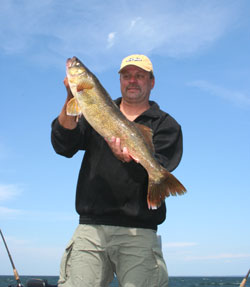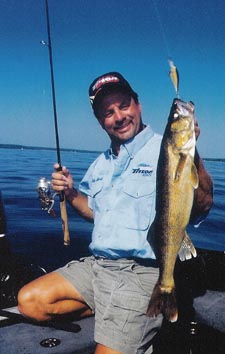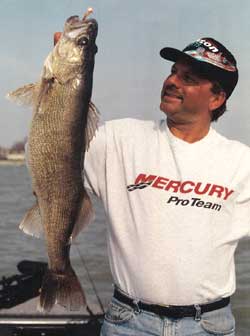 For many anglers, summertime walleye fishing is bad business.
For many anglers, summertime walleye fishing is bad business.
The species we love to pursue for most of the year has changed locations and feeding patterns. Walleyes become as difficult to catch as reliable stocks and bonds. It’s a time of year when our investments are seldom justified by their returns. Simply put, it’s a recession, and it grips many of the lakes and rivers where we enjoy productive angling during the spring and fall months. So, most anglers go into walleye shutdown, suspending operations until the economic climate improves. There are alternatives. With a little bit of strategic planning and a reallocation of your angling investment dollars, you can continue to profit while your peers are grumbling about their losses.
Phase I – Establishing goals
Developing a sound summer strategy begins in the office.
First of all, you need to determine the who, when, where, what, why and how much of your plan. Determine a budget and shape your trip around it.Most of us will be traveling to put this plan into action, so we may want to tie it into a family vacation. Better yet, make it a multiple family trip to further reduce costs. That, in turn, will help you choose a destination. Because of summer walleye migrations and behavior patterns, the most productive and consistent summer waters are major reservoirs and the Great Lakes that feature tremendous fish populations and the opportunity to catch a few trophy walleyes, too. If the wild West is something that interests you, consider Fort Peck in Montana. If you are looking to get away from it all, North Dakota’s Sakakawea or Devil’s Lake might fit your needs. If that’s a little farther than you wish to travel, there is plenty to do in South Dakota not far from the Missouri River reservoir system and lakes like Oahe, Sharpe or Francis Case, although those bodies of water aren’t known for kicking out many double-digit walleyes. The top summer Great Lakes destinations tend to be closer to major metropolitan areas with amenities like theme parks, professional sports and shopping malls. Green Bay in Wisconsin is one of the hottest walleye fisheries in the country these days. Saginaw Bay and the Bays de Noc in Michigan are superb locations. And it’s hard to beat Lake Erie anywhere from Ohio to New York. Once you’ve settled on a location that is agreeable to all involved, organize your resources. Designate a couple of individuals to develop the entertainment agenda. Put somebody in charge of accommodations and meal-planning. Brainstorm the fishing intinery. How many people want to fish? How many boats and how much gear will be needed?
 Phase II – Research
Phase II – Research
Unless you live near one of the country’s major reservoirs or top Great Lakes destinations and fish them frequently, you will be well-served by doing as much advance scouting as possible. Things don’t change that much from year to year when it comes to summertime walleyes on big water. Their behavior is fairly predictable, as are approximate locations and successful presentations. On the Great Lakes, you will typically be fishing for suspended walleyes that have migrated to deep, cool water and formed massive schools. In reservoirs, you can expect to find the fish concentrated near major points and transition areas in the deepest sections. In both cases, seasonal migrations are dictated by the availability of forage. And because walleyes have a significantly increased metabolism during the warm-weather months, they prefer larger, high-protein meals like smelt and alewife that can be found in massive schools in the cooler depths.
Old magazine or newspapers articles or tournament reports from the approximate period you will be at a particular site can be a good starting point. Learn what you can about what has worked and where it has worked in previous years. As your trip gets closer, the internet becomes a valuable source of information. Today’s anglers and guides provide a wealth of information with reports that are timely, if not always current. Keep in mind that the majority of reports are usually posted on Mondays after a weekend on the water. They may be a week old by the time you read them or are in position to put the information to use, but things won’t change much this time of year.
A few phone calls will help complete your research. Network with friends or contacts you might have in the area you plan to visit. If those connections don’t exist, aren’t available or can’t provide any current info, contact local bait shops or resort owners. They want your business now, and they also want it in the future so they are best-served by providing the most accurate and detailed information they can. Ask where the concentrations of fish can currently be found, what water temperatures to seek out, what depths to fish, what baits to use and where to find the boat ramps closest to the hot fishing.
When you get into town, visit local bait and tackle shops for information that is even more up-to-date, and check out any photos on the counter or bulletin board that might provide clues about what kind of fish have been caught the last two or three days. Some of the best information can be had at local launch facilities. Talk to anglers coming off the water. If there’s a fish-cleaning station, check it out to see what’s being prepared for the frying pan or freezer. Poke around the entrails of a walleye carcass and you can also learn what the fish are eating.
 Phase III – Putting your plan into action
Phase III – Putting your plan into action
By now, you know approximately where you will fish and what you will use.
Before you launch, evaluate recent weather patterns and consider current conditions like wind direction and cloud cover that might require adjustments in location and presentation. Visit your original target locations and put your electronics to work. Those open-water Great Lakes fish are usually easy to see on sonar. Reservoir fish relating to main lake points can be a little more difficult to pin down because they can be almost anywhere on or off that structure. In either case, a high-quality sonar unit will make you a more efficient and productive angler. I want all the detail, contours and substrate feedback I can get, in addition to GPS functions. It’s hard to beat Humminbird’s 1197 series, several of which also feature a 10.4-inch color display, preloaded Navionics mapping and side-imaging sonar that takes scouting to a whole new level by showing me not only the fish beneath my boat, but those off to the sides, as well.
Your presentation will depend on what your sonar tells you. First of all, don’t start fishing until you mark fish. If they aren’t where you expected them to be, chances are they won’t be far away. Look for slight changes in the immediate area, such as water clarity, cups in contour lines, subtle changes in depth, humps or bumps on the bottom, variances in water temperature, scum lines that attract and hold both aquatic insects and baitfish or transitions where sand might turn to gravel or mud changes to boulders.
Look for other anglers, too. Nearly every reservoir and Great Lake has a significant number of walleye fishing enthusiasts, as well as guides and charter captains. Keep an eye out for concentrations of boats that can tell you exactly where the schools of fish are holding. When you are satisfied that there are walleyes in the area, pick a presentation that puts your baits in the strike zone. Because a walleye’s eyes are located on the top of its head and it usually rises to attack its prey, always target the zone just above the fish your sonar is showing. If the fish are suspended over open water, try trolling large, 5- to 6-inch long crankbaits like No. 11 or No. 13 Normark Husky Jerks or Rapala Tail Dancers that have profiles and wobbles resembling alewife or smelt. Start with bright colors or metallic finishes on bright days and more subdued hues (blues, purples) or natural patterns on overcast outings. Make any necessary depth adjustments by using snap weights or in-line sinkers, and get your lures away from the boat with Off-Shore planer boards.
Fish that are on or near the bottom may call for a bottom-bouncer set-up, a live-bait rig or crankbaits trolled on lead-core line, depending on the depth and the size of the school. If they are tightly schooled, a live-bait approach and short drifts or trolls will keep you in the zone. Nightcrawlers and leeches fished on a six- to eight-foot leader behind a bottom-bouncer is a good way to stay on the fish in choppy, deep water. A Lindy rig might be a better way to go in calmer conditions when you don’t have to get your bait quite as deep. When possible, I like to drift-fish my live-bait presentations or slow-troll with my MinnKota Terrova bow-mount. Sometimes, I use the MinnKota for direction and a drift sock to keep my speed under 1 mph. If you have multiple anglers in the boat, those in front should use heavier weights and keep their rigs under the boat while those in back deploy lighter weights and let out more line to avoid tangles.
If your target area covers a wider swath, trolling crankbaits or spinner rigs becomes an option.
 Phase IV – Getting results
Phase IV – Getting results
By now, you should be sampling the underwater market and earning dividends on your investment. The next step is making adjustments to improve your return. While you were putting your plan into action, you should have experimented with slight variations in depth. Once you’ve found the most productive number, make sure all your lines are working that zone. Duplicate the amount of line you have out, weights, bait sizes and color patterns if you’re fishing crankbaits or spinners. If one side of the boat is outfishing the other, consider moving additional lines to that side because wind, wave action and underwater currents can often make one side fish differently than the other. If you aren’t catching any large fish, it’s possible that you need to diversify. There are several tricks you can try to add some heavyweights to your catch.
First, try moving to the outer perimeter of the area away from the concentration of boats. Second, put a bait or two just under the surface or all the way to the bottom to see if that’s where the piggies are holding. Finally, experiment with longer leader lengths. Instead of six feet between an in-line sinker and a spinner rig or crankbait or a six-foot snell behind a bottom-bouncer or rigging sinker, see if a 10- or 12-foot lead puts more trophy fish in the boat. Lastly, look to expand your territory. That can be as simple as moving away from the crowd, it can also mean taking note of the factors present in an area known to hold fish (depth, water clarity, water temperature, etc.) and looking for similar areas. Navionics Gold maps can help you identify areas with similar depth and contour.
However, one thing probably won’t change. If there aren’t baitfish present, there probably won’t be large numbers of walleyes present, either.
Summer doesn’t have to mean suspending your walleye-fishing operations.
Basically, walleyes have their own business to take care of. It’s about mergers of small companies of fish and hostile takeovers of baitfish entities. Go where the greatest populations exist and develop a solid strategic plan. You just might enjoy profits like never before.










